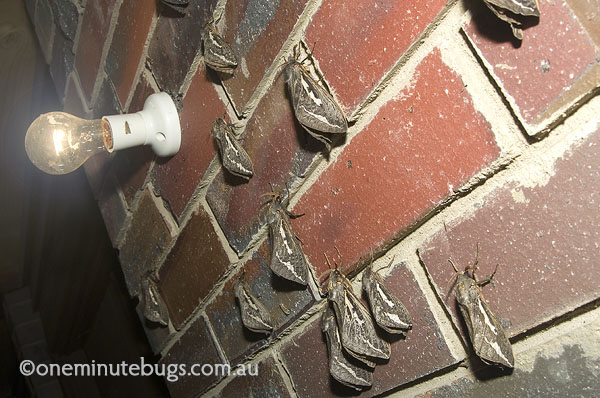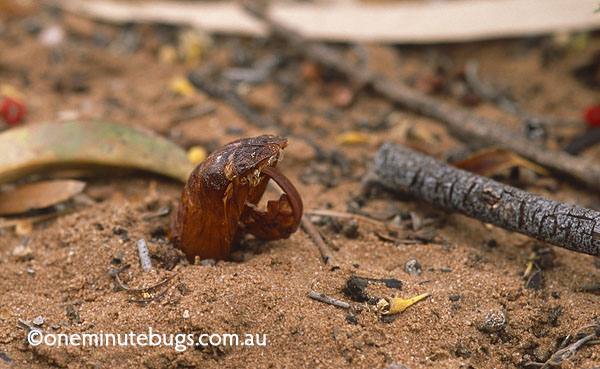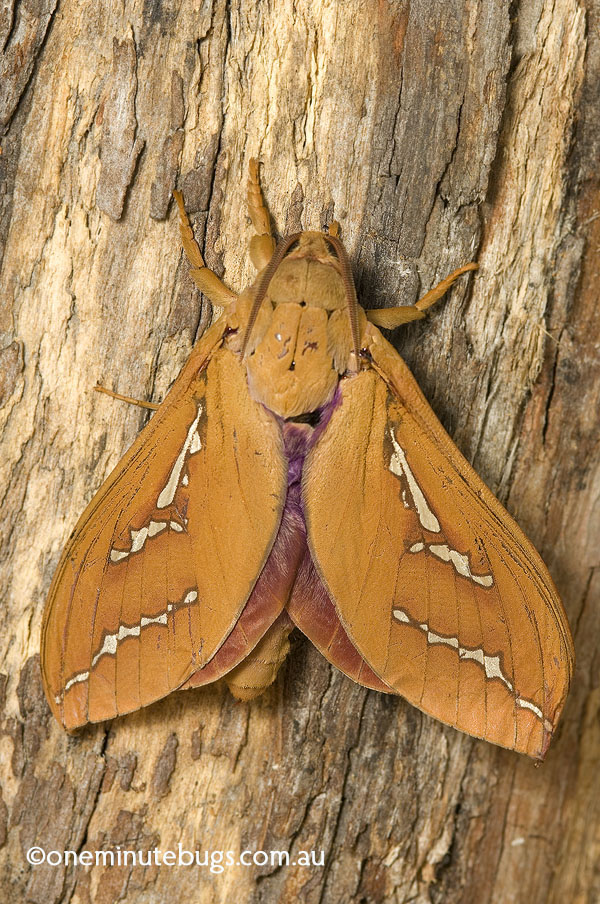Ghost moths are members of the moth family Hepialidae and there are about 150 species found in Australia. The common name “ghost moth” comes from a European species whose white ghostly males are seen hovering over open ground in a conspicuous display flight to attract females.
We have several ghost moth species at our place in the Grampians and the largest (15 cm wingspan) and most numerous is Trictena atripalpis (below). Common across the southern half of Australia, this moth and a couple of related species are known under common names such as ‘bardee’ or ‘bardi’ grub, rain moth, swift moth or ‘Waikerie’. Little wonder that entomologists use scientific names when referring to particular insects! The moths only live for one day – their only role in life is to mate and, if female, to lay eggs. The moths don’t feed or drink because they don’t have the appropriate mouth parts to do so.

Trictena atripalpis has the highest recorded egg laying capacity among non-social insects. One female was reported to lay 29,100 eggs, and when dissected 15,000 fully developed eggs were found in her ovaries. That means she had the potential to lay over 44,000 eggs. A female ghost moth lays her eggs singly while flying, ‘bombing’ them in the general direction of the roots of gum trees. The more eggs she lays during her short life the more chance there is that some hatching larvae will survive to find food and start a new generation. (Social insects such as ants, bees and termites beat that egg laying record hands down – e.g. queen driver ants can lay a couple of million eggs every month.)
The larvae of these moths live under the soil in tunnels and feed on the roots of various species of gum trees. They pupate under the ground in their tunnels and the mobile pupae wriggle towards the surface waiting for rain.
‘Rain moth’ is a great name for this moth because the adults only emerge from their pupal tunnels in autumn after heavy rain or when rain is imminent. The moths are easy to find as they are attracted to our house lights at night and some years they almost cover the wall. There are often one or two individuals who ‘jump the gun’ and when I see these early moths I know there is rain on the way. After emergence their pupal cases (below) are left protruding from the ground, sometimes mistaken by some people for cicada skins.

The ghost moths which visit us are a vital part of our local web of life, where for every creature there is another creature which will try to eat it. Ghost moth larvae are reasonably safe in their underground tunnels but emerging moths are vulnerable to attack. I will never forget the night I watched ghost moths landing on our window screens only to be systematically snatched off by insectivorous bats. Tawny frogmouths also like to eat them. The owls make quite a noise as they crash into our windows while catching the moths!
The rainforests of Australia are home to beautiful ghost moths of the genus Aenetus, commonly known as ‘splendid ghost moths’. The spectacular Aenetus mirabilis is found in northern Queensland and has a pale blue male and a green female. We have some beautiful species where we live too, such as Abantiades hyalinatus pictured below.

Absolutely amazing creatures! I’m left in total amazement when I hear of such insects whose only purpose, it seems is to become a food source for others. Lives only one day! no mouth parts to feed! produces thousands of eggs! This is why I love what I do, it never gets old. Thank you so much for sharing, very stimulating- I have to say.
Fascinating information. Thank you!